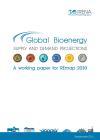

Global Bioenergy Supply and Demand Projections: A working paper for REmap 2030
Newsletter
Biomass has an auspicious future in the world’s supply of renewable energy. REmap 2030, the global roadmap developed by the International Renewable Energy Agency (IRENA), foresees a major role for modern, sustainable biomass technologies in efforts to double the share of renewables in the energy mix. This working paper, Global Bioenergy Supply and Demand Projections for the Year 2030, examines the potential in different regions and with different technologies for rapid and sustainable scale-up of this vital renewable energy resource.
If all the technology options envisaged in the REmap analysis are deployed, biomass use could reach 108 exajoules (EJ) worldwide by 2030, double the current level, and could account for 20% of total primary energy supply and 60% of final renewable energy use.
The ways we use biomass, however, can be expected to change significantly in the next few years. At present, traditional methods of space heating and cooking, such as burning firewood, account for 35 EJ, or two-thirds of total biomass use. By 2030, this would give way to modern biomass consumption, including substantially larger shares for power and transport applications. Power and district heating would reach 36 EJ (one-third of total biomass use in 2030) and transport 31EJ (almost 29%), while heat for industry and buildings would reach up to 41 EJ, of which only 6 EJ would be from less sustainable traditional uses.
While global biomass potential is sufficient to meet growing demand, different types of biomass resources are distributed unevenly. Global biomass supply potential in 2030 is estimated to range from 97 EJ to 147 EJ per year. Approximately 40% of this total would originate from agricultural residues and waste (37-66 EJ). The remaining supply potential is shared between energy crops (33-39 EJ) and forest products, including forest residues (24-43 EJ). In geographic terms, the largest supply potential — estimated at 43-77 EJ per year — exists in Asia and Europe. North and South America together account for another 45-55 EJ per year.
In terms of annual potential for different biomass types, Africa is most notable for energy crops (5-7 EJ); Asia for residues and wastes (15-32 EJ); North America for energy crops (~7 EJ) and fuel wood (~3 EJ); South America for energy crops (~16 EJ/yr); and Europe for fuel wood (0.3-13 EJ) and energy crops (~7 EJ).
Learn more about IRENA’s REmap 2030 analysis.




